Firstly, I would like to thank 64 Audio for sending me this sample to review, I have been using them a lot over the past month to get used to them, they have had well over 100hrs of burn-in.
*disclaimer: This sample was provided for the purpose of writing a review, no incentive was given to write a favourable review. All opinions expressed are my own subjective findings.
Gear Used: Audio Opus #2 / iBasso DX200 / JDS Labs Objective 2 > A6t
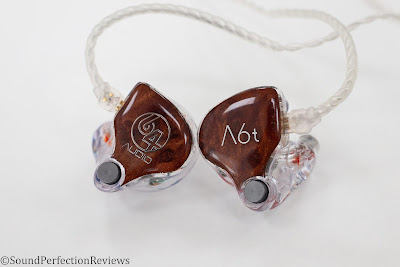
Tech specs:
https://www.64audio.com/product/A6t-Custom-In-Ear-Monitor
Packaging, Build Quality and Accessories:
The A6t come in the usual 64 Audio box which is small and simple. The outer sleeve gives you some info about the company and once you slide this off you will find a red box underneath. The top opens up to show you the carry case which is where your monitors are. There is some info on the underside of the top flap. I love the professional yet simplistic packaging of the 64 Audio products.
The A6t are impeccably finished, the clear shells are super transparent and crystal clear. There are no bubbles due to the 3D printed nature of them, the faceplates look superb in person and there are no visual flaws anywhere on them. The stock cable is silver plated, but very similar to most cables that come with custom monitors. It is functional and well built, but there is a huge market of custom cables out there that you might want to look in to. The recessed sockets are tight, and the nozzle has mesh on the end to prevent debris and wax getting into the tia driver, they have a single wide opening rather than the usual sound tubes.
Accessory wise you get the usual 64 Audio carry case which is excellent with the stock cable, not so much with an aftermarket one. The case has slots for extra apex models, it holds the cable clip and wax cleaner along with a box of desiccant to keep them moisture free. The case can also have your name engraved on it, it is a sturdy plastic one that should stand up to plenty of abuse. And they come with a wax cleaning tool and shirt clip for the cable, all that is needed to get you listening happily.
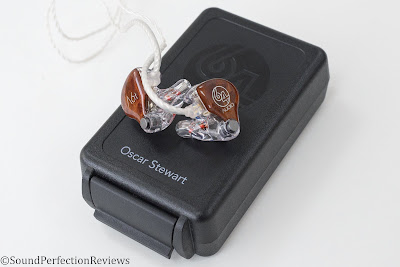
Comfort and Isolation:
The A6t are my best fitting monitors so far, this is partly down to impressions, but also down to how they make the monitors. All I can say is I can break the seal of my other CIEM's easier than I can with the A6t, they insert smoothly and fit flush and snug once in, there is no pressure anywhere so there is no discomfort even after hours of listening. Also, the apex modules prevent pressure build up internally, this I have found is excellent and you don't have to break the seal to equalise it. Overall, I have no fit issues at all with these.
Isolation will depend on the modules used, with the m20 they are easily on par with most hollow acrylic shelled CIEM's, with the m15 the isolation is lowered but I still find it more than enough for most day to day use.
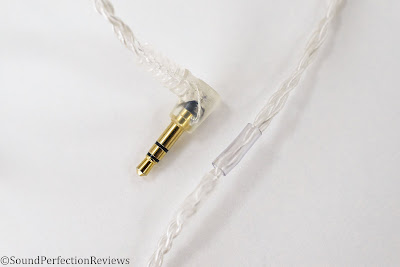
Sound:
Split into the usual categories with a conclusion at the end. This main section will be based on the sound with the m15 module, which I personally think is the better sounding module if you want a more balanced sounding monitor like the A6t is advertised as.
Lows: The A6t has a good balance between sub and mid bass, this means you get good extension but with punch added too. You don't get any excessive decay down low, they remain tight and controlled but have a certain amount of body that prevents them from sounding too flat and lifeless. There is articulation and the lows never miss a beat, they can punch with good energy and kicks never sound flat. Again, they are quite true to the source when it comes to the lows, so they can morph to the track in question, they do well with all genres but some may want a bit more energy down low for modern pop and more dance focussed music. These are marketed to be a more reference sounding CIEM, and for that the lows really do work well keeping out of the way of the rest of the sound but filling out the sound as they should.
Midrange: I would say the midrange is the forte of the A6t, it is incredibly clean and transparent that you really do pick up on every little nuance in the music. The lows don't come in and ruin the lower midrange, overall male and female vocals cut through the mix cleanly and with excellent detail. The separation between everything in the midrange is also brilliant here, you can easily pick apart the mix and hear the different layers. I would say the midrange is a tiny bit emphasised, but the overall signature is well balanced, the imaging is accurate and vocals really do stay centre stage with the instruments filling the space around them.
Highs: The tia driver really does wonders up top in comparison to the older U6 model, there is a sense of effortless refinement and extension up top that never sounds forced or strained. There is a little bias towards the presence region of the treble instead of the real upper treble but this does not translate to a fatiguing or bright signature. There is a slight dip in the transition from the midrange to the treble which allows the A6t to be sibilance free but it will still show up if it's in the recording. The main benefit of the Tia driver is its ability to create a real sense of space and air creating a wider and more layered soundstage. Those that strive for ultimate reference sound may still think the A6t does not quite cut it up top, but what they do have on their side is excellent tonality and spaciousness.
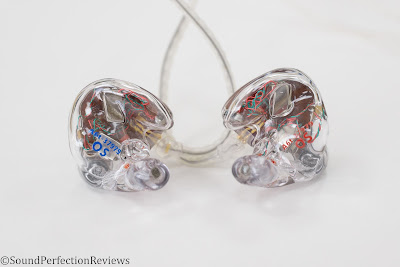
m20 module:
Going to the m20 module that are the stock module for many of 64 Audio's monitors you are greeted with a little more low-end emphasis. There is more rumble in the sub-bass and there is not quite as even a balanced between mid and sub-bass, I know quite a few people will enjoy this little bit of added body to the sound. With the m20 module the midrange is still expertly separated from the lows, but there is still a little more body to them, they don't sound quite as transparent as with the m15 but they do still sound very true to the source. Due to the slightly elevated bass with the m20, the midrange does not come across as emphasised, and is more in line with the bass in terms of presence.
The added low-end body also brings a perception of less high-end presence, there is not less treble as it is essentially very similar to the m15 in tone and extension it's just they sound fuller due to the added body down low. I find the m15 to have the cleaner and better separated sound whereas the m20 is a bit more fun and fuller, which you prefer will always come down to personal preference. As I prefer a little more of a reference type sound I like the added space and slightly better balance of the m15 module.
U6 vs A6t (both M15 modules, U6 was used with Silicone Final Tips)
The A6t is similar to the U6 in some ways, they share the same core signature which is a more reference style tuning with a little added warmth down low. The A6t improves upon the U6 by having more articulate and realistic sounding lows. The lows are slightly fuller than the U6 but they are still far from being the focus of the sound. The midrange on the U6 comes across a little more clinical, the A6t again just sounds a bit more natural and slightly less strained. The U6 has a peak a little lower in the treble region than the A6t which brings a bit more excitement, but the overall extension and tone is better on the A6t. This is where the main difference is, the tia driver adds a real sense of space and air, whereas the U6 is a little more brash and less refined in its approach to detail retrieval.
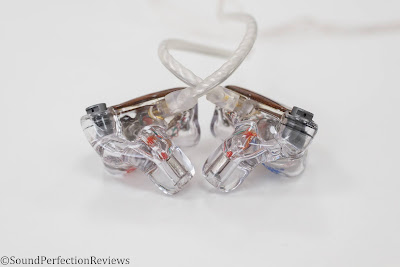
Conclusion: The A6t are one of those truly excellent products if you know what sound signature you want. They are not a strictly neutral and flat reference monitor, they have an inherent smoothness to them that is very enjoyable to listen to. But the smoothness does not come at the expense of the finer details, nor are these overly coloured. The A6t whether it be with the m15 or m20 module will always give you an honest insight into the midrange, with accurate lows and highs. The sound is natural, the tonality is spot on and these are one of those CIEM's you can genuinely put in and forget. There is plenty of detail and layering should you want to listen for it, they are a reference monitor but they don't make you want to analyse the music all the time which is refreshing.
Sound Perfection Rating: 9/10 (excellent sound and fit, highly recommended)
*disclaimer: This sample was provided for the purpose of writing a review, no incentive was given to write a favourable review. All opinions expressed are my own subjective findings.
Gear Used: Audio Opus #2 / iBasso DX200 / JDS Labs Objective 2 > A6t

Tech specs:
https://www.64audio.com/product/A6t-Custom-In-Ear-Monitor
Packaging, Build Quality and Accessories:
The A6t come in the usual 64 Audio box which is small and simple. The outer sleeve gives you some info about the company and once you slide this off you will find a red box underneath. The top opens up to show you the carry case which is where your monitors are. There is some info on the underside of the top flap. I love the professional yet simplistic packaging of the 64 Audio products.
The A6t are impeccably finished, the clear shells are super transparent and crystal clear. There are no bubbles due to the 3D printed nature of them, the faceplates look superb in person and there are no visual flaws anywhere on them. The stock cable is silver plated, but very similar to most cables that come with custom monitors. It is functional and well built, but there is a huge market of custom cables out there that you might want to look in to. The recessed sockets are tight, and the nozzle has mesh on the end to prevent debris and wax getting into the tia driver, they have a single wide opening rather than the usual sound tubes.
Accessory wise you get the usual 64 Audio carry case which is excellent with the stock cable, not so much with an aftermarket one. The case has slots for extra apex models, it holds the cable clip and wax cleaner along with a box of desiccant to keep them moisture free. The case can also have your name engraved on it, it is a sturdy plastic one that should stand up to plenty of abuse. And they come with a wax cleaning tool and shirt clip for the cable, all that is needed to get you listening happily.

Comfort and Isolation:
The A6t are my best fitting monitors so far, this is partly down to impressions, but also down to how they make the monitors. All I can say is I can break the seal of my other CIEM's easier than I can with the A6t, they insert smoothly and fit flush and snug once in, there is no pressure anywhere so there is no discomfort even after hours of listening. Also, the apex modules prevent pressure build up internally, this I have found is excellent and you don't have to break the seal to equalise it. Overall, I have no fit issues at all with these.
Isolation will depend on the modules used, with the m20 they are easily on par with most hollow acrylic shelled CIEM's, with the m15 the isolation is lowered but I still find it more than enough for most day to day use.

Sound:
Split into the usual categories with a conclusion at the end. This main section will be based on the sound with the m15 module, which I personally think is the better sounding module if you want a more balanced sounding monitor like the A6t is advertised as.
Lows: The A6t has a good balance between sub and mid bass, this means you get good extension but with punch added too. You don't get any excessive decay down low, they remain tight and controlled but have a certain amount of body that prevents them from sounding too flat and lifeless. There is articulation and the lows never miss a beat, they can punch with good energy and kicks never sound flat. Again, they are quite true to the source when it comes to the lows, so they can morph to the track in question, they do well with all genres but some may want a bit more energy down low for modern pop and more dance focussed music. These are marketed to be a more reference sounding CIEM, and for that the lows really do work well keeping out of the way of the rest of the sound but filling out the sound as they should.
Midrange: I would say the midrange is the forte of the A6t, it is incredibly clean and transparent that you really do pick up on every little nuance in the music. The lows don't come in and ruin the lower midrange, overall male and female vocals cut through the mix cleanly and with excellent detail. The separation between everything in the midrange is also brilliant here, you can easily pick apart the mix and hear the different layers. I would say the midrange is a tiny bit emphasised, but the overall signature is well balanced, the imaging is accurate and vocals really do stay centre stage with the instruments filling the space around them.
Highs: The tia driver really does wonders up top in comparison to the older U6 model, there is a sense of effortless refinement and extension up top that never sounds forced or strained. There is a little bias towards the presence region of the treble instead of the real upper treble but this does not translate to a fatiguing or bright signature. There is a slight dip in the transition from the midrange to the treble which allows the A6t to be sibilance free but it will still show up if it's in the recording. The main benefit of the Tia driver is its ability to create a real sense of space and air creating a wider and more layered soundstage. Those that strive for ultimate reference sound may still think the A6t does not quite cut it up top, but what they do have on their side is excellent tonality and spaciousness.

m20 module:
Going to the m20 module that are the stock module for many of 64 Audio's monitors you are greeted with a little more low-end emphasis. There is more rumble in the sub-bass and there is not quite as even a balanced between mid and sub-bass, I know quite a few people will enjoy this little bit of added body to the sound. With the m20 module the midrange is still expertly separated from the lows, but there is still a little more body to them, they don't sound quite as transparent as with the m15 but they do still sound very true to the source. Due to the slightly elevated bass with the m20, the midrange does not come across as emphasised, and is more in line with the bass in terms of presence.
The added low-end body also brings a perception of less high-end presence, there is not less treble as it is essentially very similar to the m15 in tone and extension it's just they sound fuller due to the added body down low. I find the m15 to have the cleaner and better separated sound whereas the m20 is a bit more fun and fuller, which you prefer will always come down to personal preference. As I prefer a little more of a reference type sound I like the added space and slightly better balance of the m15 module.
U6 vs A6t (both M15 modules, U6 was used with Silicone Final Tips)
The A6t is similar to the U6 in some ways, they share the same core signature which is a more reference style tuning with a little added warmth down low. The A6t improves upon the U6 by having more articulate and realistic sounding lows. The lows are slightly fuller than the U6 but they are still far from being the focus of the sound. The midrange on the U6 comes across a little more clinical, the A6t again just sounds a bit more natural and slightly less strained. The U6 has a peak a little lower in the treble region than the A6t which brings a bit more excitement, but the overall extension and tone is better on the A6t. This is where the main difference is, the tia driver adds a real sense of space and air, whereas the U6 is a little more brash and less refined in its approach to detail retrieval.

Conclusion: The A6t are one of those truly excellent products if you know what sound signature you want. They are not a strictly neutral and flat reference monitor, they have an inherent smoothness to them that is very enjoyable to listen to. But the smoothness does not come at the expense of the finer details, nor are these overly coloured. The A6t whether it be with the m15 or m20 module will always give you an honest insight into the midrange, with accurate lows and highs. The sound is natural, the tonality is spot on and these are one of those CIEM's you can genuinely put in and forget. There is plenty of detail and layering should you want to listen for it, they are a reference monitor but they don't make you want to analyse the music all the time which is refreshing.
Sound Perfection Rating: 9/10 (excellent sound and fit, highly recommended)















